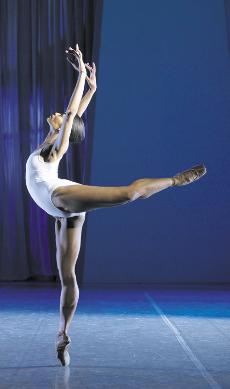Friday April 27 marked the world premiere of “Salomé Dances for Peace,” the first full-length repertory ballet performed by José Mateo Ballet Theatre. Set to and named after Terry Riley’s musical score “Salomé”, the ballet features mesmerizing choreography executed by a talented professional company consisting of only seventeen dancers.
The setting for “Salomé Dances for Peace” is the Sanctuary Theatre located at 400 Harvard Street in Cambridge. The theatre features cabaret style seating that provides an up-close viewing experience where the dancers perform on the same level as their audience. By placing the audience and the dancers face to face with one another the element of separation, which is common to most stage productions, is removed.
Initially, I was somewhat uncertain about attending this performance. With a name like “Salomé Dances for Peace,” I didn’t know what to expect. However, the experience was one well worth having. In the “Notes from the Director” section of the program, Mateo explains that he began his approach to choreographing with the intention of creating a work that depicts a mythological seductress who, through her dancing, influences leaders to bring about world peace. He admits though, that as he progressed further into the process of setting a ballet to Riley’s powerful musical score, the focus became more about the dancing than anything else. Indeed, as I was watching “Salomé Dances for Peace” I found myself concentrating not so much on its intended plot but on Mateo’s choreography.
Dancers Elisabeth Scherer and Sybil Watkins split the title role of Salomé, portraying her in terms of her opposing sides rather than as just one being. The performance opens with both women facing each other in the center of the stage. They begin moving together in the manner of a mirror reflection, occasionally breaking away and then returning back to one another. Scherer and Watkins excel not only at complimenting each other in their performance together, but also at commanding the stage individually. Despite challenging and complex choreography consisting of countless extensions and lengthy balances, both dancers consistently move with grace, strength and elegance.
It was not only Scherer and Watkins who stood out in this production. The entire cast shined as a whole. They performed well with one another, giving the impression that an interconnected energy was present between them on the stage at all times. Corps movements were perfectly synchronized. I was especially impressed at several points throughout the ballet when a group of five or more dancers moved together giving the impression of being one body. Watching Mateo’s company perform also gave me the sense of constant motion. Even when dancers would occupy stationary poses, there was the impression of a continuous lengthening and stretching present at all times.
In its 21st season, José Mateo Ballet Theatre is unique because it is the only ballet company in New England featuring an entire repertoire consisting of over eighty pieces of choreography produced by its own resident choreographer and artistic director. As the newest addition, “Salomé Dances for Peace” is an engaging ballet that derives strength not only through its thought-provoking and complex choreography, but also through the presence of a truly talented company of dancers.
For ticket or other information about the organization call (617)354-7467, or log onto www.BalletTheatre.org





















































